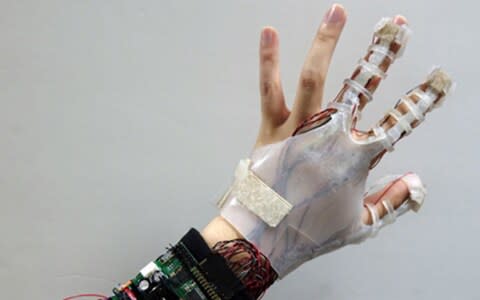Glove invented to allow wearer to feel objects in virtual reality

A glove which allows the wearer to touch objects in virtual reality, so that chess players could actually feel their pieces when playing through a computer, has been invented by scientists.
The silicone rubber gadget, which wraps around the hand, works by using sensors which detect movements in fingers as they reach to grab an object, then feeds back the corresponding sensation.
To replicate the feeling of touch, small pockets of silicon swell with air, and vibrate slightly beneath the fingertips to give the sense that the fingers are actually in contact with something.
The pockets are usually kept squashed flat by an electrostatic charge but when the gloved hand reaches out for an object the current is switched off causing them to expand, to press the sensitive fingerpads.

Korean scientists have trialled the new device on a chess game, with wearers using a virtual reality headset so it looks and feels like they are moving a 3D chess piece in front of them
But lead researcher Dr Youngsu Cha, of the Korea Institute of Science and Technology, said it could allow doctors to perform surgery from across the world, or even help people stay in touch physically.
“Other applications of the glove would be virtual reality games or teleoperation,” he said.
“Also, humans could meet in the virtual world. And the glove is useful for allowing people to be able to touch each other.”
Surgeons already carry out remote surgery, but it is done using joysticks. The new method could allow doctors to feel and manipulate surgical equipment precisely , or practice operations.
The glove even allows the wearer to recognise the shape of the object, picking up the sweep of curves.
The research was published in the journal Scientific Reports.

 Yahoo News
Yahoo News 
